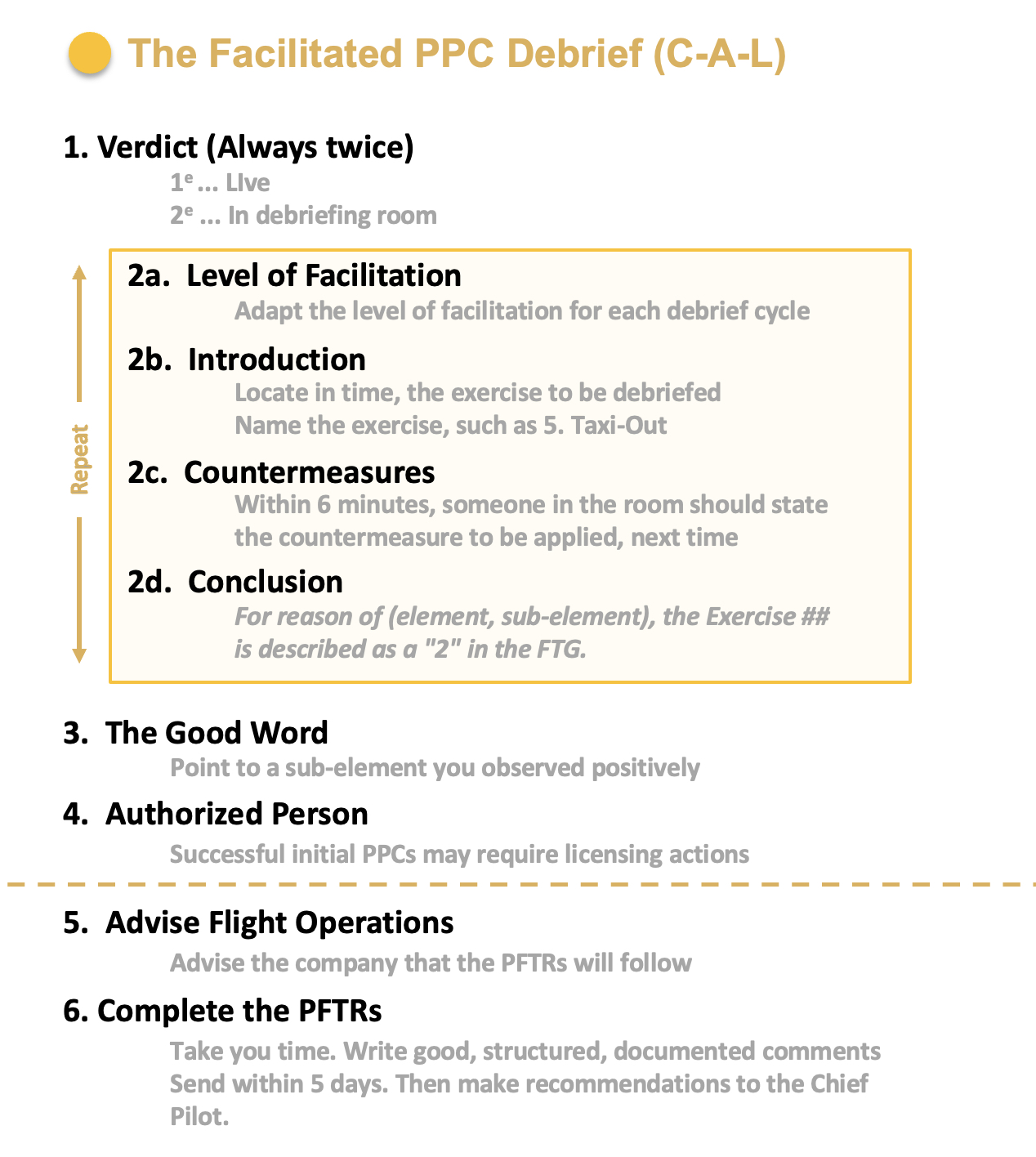
It is neither necessary nor productive to go through the Facilitated Debrief when the reason for the "2" score is technical only. The Facilitated Debrief is used for non-technical issues.
1. Verdict. The PPC is successful and you (the ACP) state it twice. The first time, at the moment the PPC ends. Then once again, in the debriefing room. Avoid any kind of ambiguity about the outcome. You may learn during the debriefing that you missed something. It's too late. The pilots were successful. It's now time to talk about it.
Congratulations to both of you. The PPCs will be issued/renewed. It was a good ride with (some, 1, 2, 3) moments that are described as a "2" in the Flight Test Guide. Let's meet in the debriefing room at half past two o'clock, downstairs. Please take your belongings with you.
Avoid setting the meeting time in x minutes, but state the time (hours, minutes). Then, when you are ready, begin the debrief by stating the verdict again.
Congratulations again. It was a good ride for both of you. The two PPCs will be (issued/renewed). There are a couple of exercises that match the FTG's description of a "2". Let's take a few minutes to talk about them.
2. Debrief the exercises scored "2".
If the ride ended with two exercises scored "2", the following debrief cycle (2a, 2b, 2c, 2d) will be performed twice.
2a. Level of Facilitation. Begin each debrief cycle by choosing the desired level of facilitation. Offer the pilots to debrief themselves (High Level Facilitation), making sure they include non-technical countermeasure(s) to be deployed, next time they meet the same threats, to manage similar errors. Some crews lack experience in analyzing non-technical CRM aspects of their PPC without assistance. You may lead the discussion more directly towards non-technical elements (Medium Level Facilitation). See Table below.
2b. Introduction. The pilots were typically in PPC mode for hours. You need to "locate" the exercises to be debriefed in time. Introduce the exercise with a sentences like:
First, let'd discuss Exercise 5. Taxi out. Ground Control cleared you to taxi to runway 06L via the North Ramp. Later ATC updated your clearance because the active runway was changed to 06R.
2c. Countermeasures. The main objective of any Facilitated Debrief is to identify how the pilots wish to proceed in the future if, together, they meet similar challenges. Overall debriefing duration is certainly an issue. Avoid generic questions sush as How did you feel when... Rather ask focussed, directed questions that point to where you want the conversation to go. Multiple-choice questions are efficient because they frame the debate. Use the FTG's langage: the 4 non-technical elements and associated 16 sub-elements. If after 4 or 5 minutes you haven't heard from the pilots how they would achieve more safety margins, move on to Conclusion for that specific exercise.
2d. Conclusion. Close the cycle by stating the reason why the "2" score was assigned to the exercice. Learn standard sentences for this purpose, with "plug-in" elements.
For you Marianne as PF, for reasons of (element, sub-element), the exercise 5. Taxi-Out is described in the Flight Test Guide as a "2". For you George as PM, for reasons of (element, sub-element), as this point the exercise 21. PM was described as a "2".
Always end the cycle with the same closure. Always refer to the Minister's elements and sub-elements that contributed to the degraded score. Repeat the debrief cycle for each exercise that will be documented as "2" in their respective PFTR.
3. The Good Word. The good word should be structured, not simply improvised, to effectively tell the pilot he/she is much more than an exercise scored "2". Base your message on one of the 6 elements you observed positively, ideally a non-technical element. Learn a formatted sentence like:
Let's take a moment to see how the Flight Test Guide describes a cockpit with optimum (sub-element). (describe why this went well) Clearly, this is one of your strengths you can build on.
Do you have any questions?
4. Authorized Person. Successful initial PPC may lead to a new Type Rating and/or a new Instrument Rating. Only once the PPC is considered successful, ask the pilot(s) to date and sign their respective 0083 Form. Then proceed with the temporary privilege(s) in the pilots' ADBs.
At this point, the pilots leave the building.
5. Advise Flight Operations. Use the usual channels to inform the company about today's outcome and inform them the PFTRs will follow.
6. Complete the PFTR. You have five days to produce quality PFTRs. You can certainly take a few hours. Pilots have no right on the production of the PFTR. Once the pilots leave the building, quickly gather your notes, a copy of the script you used, fill the blanks on your draft paper. Take your time to draft several versions of what will constitute the official PFTR comments.
Remember that neither TC or TATC may amend the content of a successful PPC PFTR, simply because the pilot disagrees with the score of "2" of an exercise.
Your recommendations to the Chief Pilot are crucial for steering the Training Department and for future PPC scripts development.
Levels of facilitation ACPM 6.45 (4)
High Level |
|
Medium Level |
|
Low Level |
|
Facilitated Debrief Pointers
- Do not lecture or make long speeches
- Do not give the impression that only ACP's views count
- Keep the discussion crew-centered
- Re-word question instead of giving answers
- Ask the quiet pilot to talk, redirect one's comment to the other pilot
- Use silence/pauses to elicit thoughtful crew responses
- Ask follow-up questions that require in-depth analysis
- Ask pilot to analyse the reasonning behind their decisions
- Do not interupt the crew while they still want to talk
- Give your own analysis only after the crew did
- Reinforce good crew performance after they provided analysis

